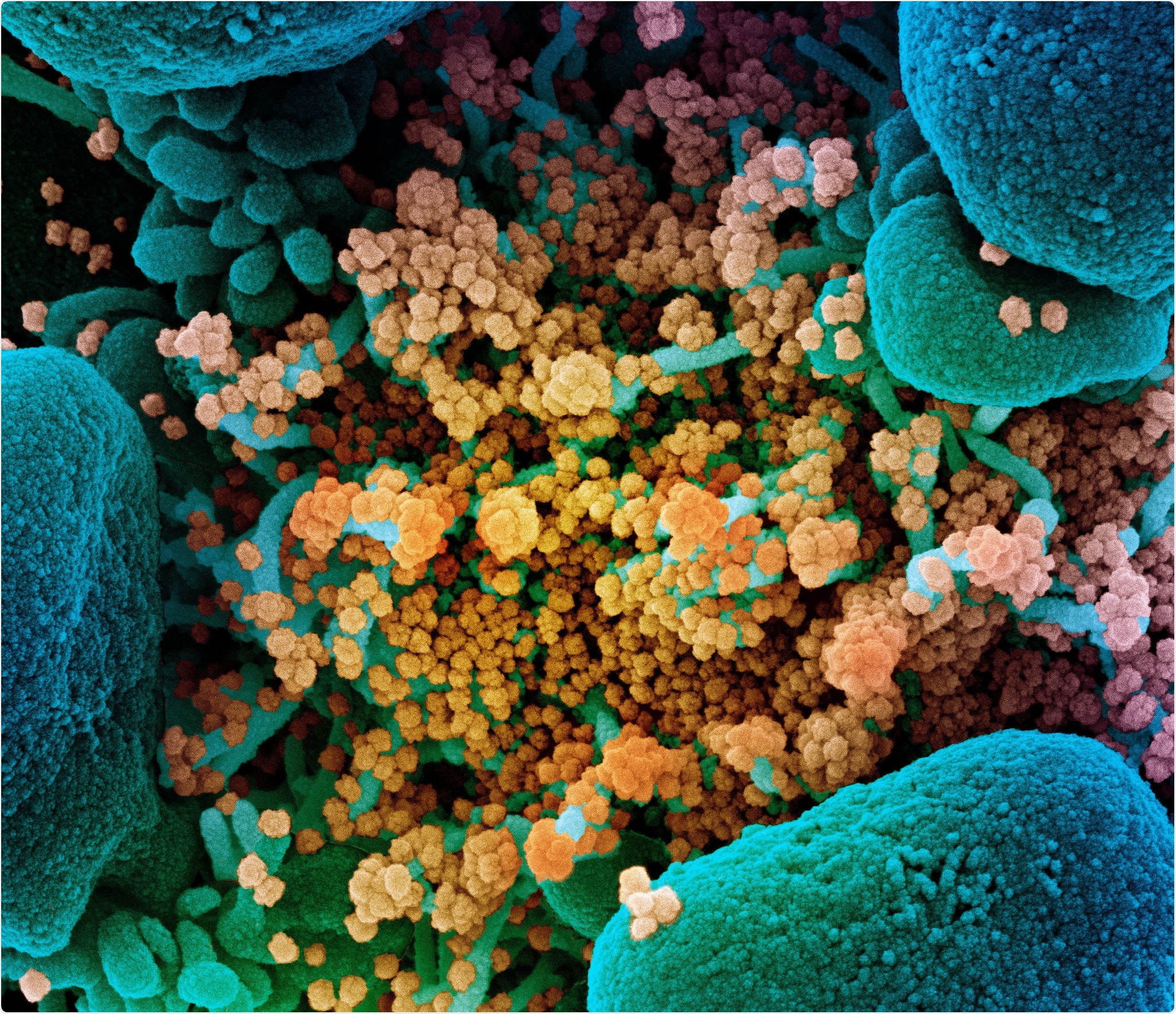A recent study from the University of North Carolina at Chapel Hill revealed how selective pressure helps in preserving secondary RNA structures in coronavirus genomes, unveiling a pivotal role of these elements in viral replication and pathogenesis. The paper is currently available on the bioRxiv* preprint server.
Coronaviruses have caused numerous epidemic and pandemic outbreaks during the past twenty years. The ongoing pandemic of coronavirus disease (COVID-19) is caused by SARS-CoV-2, while SARS-CoV and MERS-CoV caused severe acute respiratory syndrome (SARS) and Middle East Respiratory Syndrome (MERS) outbreaks, respectively.

Novel Coronavirus SARS-CoV-2 Colorized scanning electron micrograph of an apoptotic cell (blue) heavily infected with SARS-COV-2 virus particles (yellow), isolated from a patient sample. Image captured at the NIAID Integrated Research Facility (IRF) in Fort Detrick, Maryland. Credit: NIAID

 *Important notice: bioRxiv publishes preliminary scientific reports that are not peer-reviewed and, therefore, should not be regarded as conclusive, guide clinical practice/health-related behavior, or treated as established information.
*Important notice: bioRxiv publishes preliminary scientific reports that are not peer-reviewed and, therefore, should not be regarded as conclusive, guide clinical practice/health-related behavior, or treated as established information.
Today it is clear that, without vaccines and targeted antiviral drugs, we are severely ill-prepared to handle coronavirus outbreaks like the one we are currently facing. Hence, an improved understanding of the molecular mechanisms regulating coronavirus replication and pathogenesis is urgently needed.
And although we know that secondary RNA structures play crucial roles in various aspects of coronavirus replication, their extent and conservation across an array of coronavirus genomes are still elusive.
Taking into account the length of coronavirus RNA genomes (i.e., among the largest single-strand genomes of all RNA viruses), there are likely additional RNA structures that can regulate coronavirus replication and the appearance of the disease.
This is why researchers from the University of North Carolina at Chapel Hill in the US aimed to elucidate highly structured RNA regions throughout the MERS-CoV, SARS-CoV, and SARS-CoV-2 genomes.
Hunting conserved RNA structured regions and mutational variance
In order to identify significant regions of secondary RNA structure in the genomes of the aforementioned viruses, these scientists performed selective 2'-hydroxyl acylation analyzed by primer extension and mutational profiling (SHAPE-MaP) of virus-associated RNA. A structural model for stable RNA elements was additionally created in each genome.
Moreover, to appraise whether RNA structuredness acts as a driver of mutational variance across viral strains, they executed multiple sequence comparison by log-expectation (MUSCLE) alignment analysis of 350 MERS-CoV, 141 SARS-CoV, and 1,542 SARS-CoV-2 genomes.
Finally, they have also performed covariation analysis to evaluate the conservation of structuredness. Additionally, this type of analysis can determine if two nucleotide changes occurred in tandem to conserve the secondary RNA structure.
Highly structured RNA under intense selective pressure
"Using SHAPE-MaP analysis, we found that members of the Coronaviridae, MERS-CoV, SARS-CoV, and SARS-CoV-2, contain highly stable, structured RNA regions throughout their genomes", study authors highlight their main findings.
More specifically, SARS-CoV and SARS-CoV-2 genomes were more thoroughly structured than the MERS-CoV genome, indicating that – even within the betacoronavirus family that contains all three viruses – RNA structuredness may be unique to viral species.
But outside of structurally-conserved, non-coding regions of the viral genome, only a single RNA structure has found to be conserved across all three viruses. Nonetheless, conserved highly stable structured regions with similar RNA structures in direct comparison of SARS-CoV and SARS-CoV-2 were clearly demonstrated.
"This suggests these regions are under greater selective pressure than their non-structured counterparts, and their likely importance in SARS-like coronavirus replication," further explain study authors.
Conversely, the researchers found discernible structural differences between MERS-CoV and both SARS-CoV/SARS-CoV2, even within the known functional RNA structures. They have also pinpointed a plethora of highly stable and conserved structured regions in SARS-CoV and SARS-CoV-2 with significant similarities.
Towards new therapeutic targets and rational vaccine design
"In conjunction with the fact that structured regions in SARS-CoV showed lower sequence variance than non-structured regions, we hypothesize that RNA structuredness and specific RNA secondary structures exert selective pressure on sequence diversity," highlight study authors in their bioRxiv paper.
This suggests that these structures play notable roles in SARS-like coronavirus replication, and possibly pathogenesis; hence, disrupting these conserved structures could indeed be a promising strategy to generate novel attenuated SARS-CoV-2 vaccines.
In any case, understanding the exact way how these novel RNA structures can regulate SARS-CoV-2 replication could subsequently lead to the development of new therapeutic targets and accelerate rational vaccine design.

 *Important notice: bioRxiv publishes preliminary scientific reports that are not peer-reviewed and, therefore, should not be regarded as conclusive, guide clinical practice/health-related behavior, or treated as established information.
*Important notice: bioRxiv publishes preliminary scientific reports that are not peer-reviewed and, therefore, should not be regarded as conclusive, guide clinical practice/health-related behavior, or treated as established information.
Journal reference:
- Preliminary scientific report.
Sanders, W. et al. (2020). Comparative analysis of coronavirus genomic RNA structure reveals conservation in SARS-like coronaviruses. bioRxiv. https://doi.org/10.1101/2020.06.15.153197.